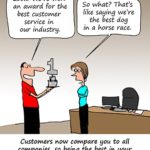 Does this comic resonate with you? As the old adage goes, figures don’t lie but liars figure. Don’t fall into the trap of thinking that’s good enough because it can always be better! Look again at the comic because it borders on Fake News and no company wants to be branded as that. It is critical that you are relating the information in a manner that is useful. That said, reporting has always been the mainstay of a Contact Center. It will likely continue to be a focus as the reporting and analytic capabilities evolve. However, before diving into the reporting aspects of a Contact Center, it is important to understand what your actual Contact Center reports should be, what it should provide, in what digestible time slots, and to whom. Reporting should be relevant, timely, and accurately provided to key stakeholders before they ask for it. Anticipate your customers’ needs and surpass their expectations.
Does this comic resonate with you? As the old adage goes, figures don’t lie but liars figure. Don’t fall into the trap of thinking that’s good enough because it can always be better! Look again at the comic because it borders on Fake News and no company wants to be branded as that. It is critical that you are relating the information in a manner that is useful. That said, reporting has always been the mainstay of a Contact Center. It will likely continue to be a focus as the reporting and analytic capabilities evolve. However, before diving into the reporting aspects of a Contact Center, it is important to understand what your actual Contact Center reports should be, what it should provide, in what digestible time slots, and to whom. Reporting should be relevant, timely, and accurately provided to key stakeholders before they ask for it. Anticipate your customers’ needs and surpass their expectations.
Competing for consumer wallet-share and mind-share requires businesses be more connected than ever. The connected referred to is not a cloud versus premises, or even extended likes on social media, but rather allowing customers to choose how, when, and where they want to do business. With all the noise in the marketplace with the competing solution providers, it is difficult to know the correct end game to aim for. Noise levels and possible solutions are at an all-time high. In these times creative solutions and real value add can easily be drowned out in the cacophony of the me-too’s.
Think about it, customers are much more demanding, so you must demand more from your business solutions. Contact Centers are at an inflection point in deciding what to offer their customers and quantifying the business justification for making changes. Many industry professionals are touting the way to nirvana is embracing omnichannel experiences. Businesses look at the marketing hype and say, “Isn’t that simply a newfangled way of saying multichannel?” The answer is honestly, no. There are real business differences in the successful approach of omnichannel versus multichannel, which have a direct impact on many areas of internal operations, as well as the overall reporting analytics and metrics. It is worthwhile to take a look at and understand the differences.
OMNICHANNEL
Businesses embrace omnichannel to gain a holistic view of their customer’s engagement journey, regardless of the contact channel, i.e. phone, email, web chat, sms, and so forth. To accomplish this, the experience has to be seamless and within context across all contact channels. For example, a customer may want to use their mobile application, the company’s website, make a phone call, or post in social media to begin their transaction trek. Along the way the customer’s choices, interactions, responses, and data is not only bi-directional, but also reportable. The goal is a frictionless journey for the customer when they interact with technology or humans.
Organizational workforce empowerment and agility are also top considerations to delivering an outstanding omnichannel experience. When interacting with a customer it is critical to have visibility to all of the activity corresponding to the current journey, as well as to previous interactions. This makes the interaction a relevant conversation which can achieve the traditional target of first contact resolution. Tools in the hands of the workforce which provide detailed visibility are necessary. First contact resolution is by definition faster time to customer satisfaction.
Established organizations may have significant challenges as they migrate to an omnichannel model due to established silos of information and dated processes. Cumbersome processes alone can prevent workforce empowerment when dealing with customers, often resulting in multiple transfers. Remember the old contact center adage: Touch them twice, buyer turns to ice.
Some businesses need or want to take advantage of the more popular trends of show-rooming and the reverse which is web-rooming to compete and gain wallet-share of their customers. To help clarify this original retail trend, show-rooming involves the shopper who goes to stores to test and touch products yet completes their purchase online often from a competitor. The reverse or web-rooming is the shopper who completes all the research online then enters the store for the final purchase. Newer businesses tend to willingly embrace these trending types of experiences for their customers, but may not have the depth of proficiency internally to effectively dictate the desired outcomes. This delicate balance requires investment and commitment from all levels of the business.
MULTI-CHANNEL
As technology capabilities of have evolved, the ability to use voice, email, web chat, or sms as distinctive interaction channels has been the focus of traditional voice Call Centers. Adding in these channels has been difficult for established organizations to embrace as they have been more point solution oriented. Multi-channel is not a poor strategy, but rather a different business model.
Typically, the business teams supporting a multichannel approach include departments which are primarily single channel focused. Members of these discrete teams are extremely efficient at a given channel but are often disconnected with other channels customers may want to access for transactions. Valuable resources trapped in isolated channels is like waiting at the wrong bus stop to get home. Valuable time lost waiting is an opportunity to improve.
As individuals and businesses, we are creatures of habit. Consumers who have received great service from a business over the phone, as an example, may simply want to continue with only this channel as it works. Other customers who have become accustomed to engaging with businesses in ways they desire, may grow to resent the lack of choice. Knowing your customer personas can help identify if your strategy is short-term or long-term for optimized customer relationships.
When a given business commits to putting their customers at the center of the product and services decisions, the implied decision is that they are on the road to omnichannel. Consider the methodology from a product viewpoint. Multi-channel means marketing a product in the same way across multiple channels, while omnichannel means that the content is adapted to the channel. It is like having a telescope to see but looking through the wrong end.
Customers don’t behave equally in every channel and, for that reason, businesses should not address customers in the same manner at each of the touch points. However, it is critical to note if a channel is offered, such as email or web chat, the processes and responsibility to timely respond need to be in place. Technology enables the full omnichannel experience for customers but will prove most successful when the expanded value to the organization is defined and has full leadership support for that evolution.
Businesses should provide the methods for engagement to optimize customer experience in a reliable, measurable and managed way.
(Part 2 will be posted later this week, thank you)






2 replies to "Contact Center – Digital Transformation Reporting (Part 1)"
I’m pretty sure you misspelled the word “reasearch” on your site. You might want to check out a site like SpellRadar.com or SiteCheck.com which have helped me with problems like this in the past.
Hi John
Thank you for the pointer. Appreciate you stopping by. Take care.